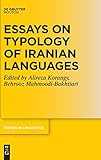Essays on Typology of Iranian Languages / ed. by Alireza Korangy, Behrooz Mahmoodi-Bakhtiari.
Material type: TextSeries: Trends in Linguistics. Studies and Monographs [TiLSM] ; 328Publisher: Berlin ; Boston : De Gruyter Mouton, [2019]Copyright date: ©2019Description: 1 online resource (VII, 183 p.)Content type:
TextSeries: Trends in Linguistics. Studies and Monographs [TiLSM] ; 328Publisher: Berlin ; Boston : De Gruyter Mouton, [2019]Copyright date: ©2019Description: 1 online resource (VII, 183 p.)Content type: - 9783110601749
- 9783110602104
- 9783110604443
- 491.5 23
- PK6014 .E873 2019
- online - DeGruyter
- Issued also in print.
| Item type | Current library | Call number | URL | Status | Notes | Barcode | |
|---|---|---|---|---|---|---|---|
 eBook
eBook
|
Biblioteca "Angelicum" Pont. Univ. S.Tommaso d'Aquino Nuvola online | online - DeGruyter (Browse shelf(Opens below)) | Online access | Not for loan (Accesso limitato) | Accesso per gli utenti autorizzati / Access for authorized users | (dgr)9783110604443 |
Frontmatter -- Acknowledgments -- Contents -- Iranian languages and linguistic typology -- Ergativity in New West Iranian -- Aspect in Iranian two systems: Persian and Pashto -- Loss vs. expansion of gender in Tatic languages: Kafteji (Kabatei) and Kelāsi -- Mazandarani: A typological survey -- Referential Null Subjects (RNS) in colloquial spoken Persian: Does speaker familiarity have an impact? -- A typological study of (in)definiteness in the Iranian languages -- The quotative marker in Gilaki -- Plural marking in the New West Iranian languages and dialects: a historical and typological approach -- A typological sketch of the Jewish Iranian dialects -- Epilogue -- Index
restricted access online access with authorization star
http://purl.org/coar/access_right/c_16ec
The Iranian languages are one of the world's major language families. With an estimated 150 to 200 million native speakers, these languages constitute the western group of the larger Indo-Iranian family, which represents a major eastern branch of the Indo-European languages. Geographically, the Iranian Languages are spoken from Central Turkey, Syria and Iraq in the West to Pakistan and western edged of Xinjiang Uygur Autonomous Region of China in the east. Iranian languages have long been among the major interests of the philologists and general linguists, and European scholars have made tremendous contributions to the study of this language family. In light of such efforts, now we know that the Iranian languages can be historically divided into three phases, that are old, middle and new Iranian languages, and the new Iranian languages may be generally grouped as Eastern and Western. In recent years, the orientation towards typology has led to the appearance of somewhat more ponderance on the subject but the work has not included description of some of the very important languages of the Caspian, and or of the religious minorities (such as those of the Zoroastrians or the Jewish community), of the four-fold Central Plateau dial.
Issued also in print.
Mode of access: Internet via World Wide Web.
In English.
Description based on online resource; title from PDF title page (publisher's Web site, viewed 25. Jun 2024)


